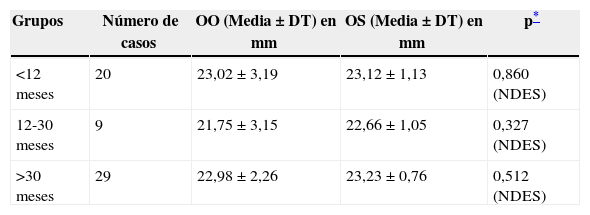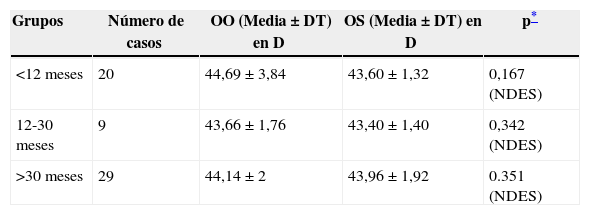Estudiar el efecto de la cirugía de las cataratas congénitas unilaterales sobre el crecimiento ocular y el aplanamiento corneal.
MétodosRealizamos un estudio transversal sobre 59 pacientes intervenidos de cataratas congénitas unilaterales. La mediana de edad de los pacientes en el momento del diagnóstico fue de 17 meses (rango intercuartílico: 5-39 meses), la mediana de edad en el momento de la intervención fue de 28 meses (rango intercuartílico: 8-52 meses) y el tiempo medio de seguimiento fue de 149,7±69,9 meses (rango: 30-319 meses). Se midió la longitud axial y la curvatura corneal de ambos ojos en todos los pacientes, tanto los operados de catarata congénita como los no operados. Estos valores fueron comparados entre sí.
ResultadosNo se evidencian diferencias estadísticamente significativas entre ambos ojos (operados y no operados) respecto a la longitud axial (p=0,327, prueba t de Student) ni a la curvatura corneal (p=0,078, prueba t de Student). Al realizar un subanálisis dependiendo de la agudeza visual y la edad de los pacientes en el momento de la intervención, encontramos diferencias estadísticamente significativas solo respecto a la longitud axial en el grupo de pacientes que no presentan ambliopía profunda (p= 0,007, prueba t de Student), con menor longitud axial en los ojos intervenidos respecto a los ojos sanos.
ConclusionesNo encontramos cambios significativos en el crecimiento axial de los ojos intervenidos de catarata congénita unilateral respecto a sus ojos adelfos. Solo encontramos menor longitud axial en los ojos intervenidos con respecto a los ojos sanos en el grupo que no presentaba ambliopía profunda. No se hallaron diferencias respecto al aplanamiento corneal en los ojos operados con respecto a los ojos adelfos tras la cirugía de las cataratas congénitas unilaterales.
The aim of this article is to study the effect of unilateral congenital cataract surgery on ocular growth and corneal flattening.
MethodsThis is a cross-sectional study of 59 patients operated on due to a unilateral congenital cataract. The median age of the patients at the time of diagnosis was 17 months (interquartile range, 5-39 months). The median age at cataract the time of surgery was 28 months (interquartile range, 8-52 months), and the mean follow-up between cataract surgery and assessments was 149.7±69.9 months (range, 30-319 months). Axial length and corneal curvature were measured in both operated and non-operated eyes, comparing the results between them.
ResultsThere were no statistically significant differences for axial length growth or corneal flattening between operated and non-operated eyes: axial length (P=.327, Student t test) and corneal curvature (P=.078, Student t test). A sub-analysis was performed using the visual acuity and the age of the patient at the time of surgery. The only statistically significant data (P=.007, Student t test) was a lower axial length in operated eyes compared to non-operated eyes, in the non-deep-amblyopia group.
ConclusionsNo significant axial length growth modifications were observed between operated and non-operated eyes. Only the non-deep-amblyopia group presented with a lower axial length in the operated eyes compared to non-operated eyes. No significant differences in corneal flattening were found between groups after unilateral congenital cataract surgery.
Artículo
Comprando el artículo el PDF del mismo podrá ser descargado
Precio 19,34 €
Comprar ahora













